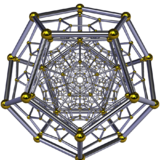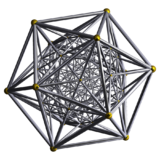H4 polytope
 120-cell |
 600-cell |
In 4-dimensional geometry, there are 15 uniform polytopes with H4 symmetry. Two of these, the 120-cell and 600-cell, are regular.
Visualizations
Each can be visualized as symmetric orthographic projections in Coxeter planes of the H4 Coxeter group, and other subgroups.
The 3D picture are drawn as Schlegel diagram projections, centered on the cell at pos. 3, with a consistent orientation, and the 5 cells at position 0 are shown solid.
| # | Name | Coxeter plane projections | Schlegel diagrams | Net | ||||||
|---|---|---|---|---|---|---|---|---|---|---|
| F4 [12] |
[20] | H4 [30] |
H3 [10] |
A3 [4] |
A2 [3] |
Dodecahedron centered |
Tetrahedron centered | |||
| 1 | 120-cell {5,3,3} |
 |
60px | 60px | 60px | 60px | 
|

|

| |
| 2 | rectified 120-cell r{5,3,3} |
 |
60px | 60px | 60px | 60px | 
|

|

| |
| 3 | rectified 600-cell r{3,3,5} |
 |
60px | 60px | 60px | 60px | 
|

|

| |
| 4 | 600-cell {3,3,5} |
 |
60px | 60px | 60px | 60px | 
|

|

|

|
| 5 | truncated 120-cell t{5,3,3} |
 |
60px | 60px | 60px | 60px | 
|

|

| |
| 6 | cantellated 120-cell rr{5,3,3} |
 |
60px | 
|

|

| ||||
| 7 | runcinated 120-cell (also runcinated 600-cell) t0,3{5,3,3} |
 |
60px | 
|

|

| ||||
| 8 | bitruncated 120-cell (also bitruncated 600-cell) t1,2{5,3,3} |
 |
60px | 
|

|

| ||||
| 9 | cantellated 600-cell t0,2{3,3,5} |
 |
60px | 60px | 60px | 60px | 
|

|

| |
| 10 | truncated 600-cell t{3,3,5} |
 |
60px | 60px | 60px | 60px | 
|

|

| |
| 11 | cantitruncated 120-cell tr{5,3,3} |
 |
60px | 
|

|

| ||||
| 12 | runcitruncated 120-cell t0,1,3{5,3,3} |
 |
60px | 
|

|

| ||||
| 13 | runcitruncated 600-cell t0,1,3{3,3,5} |
 |
60px | 
|

|

| ||||
| 14 | cantitruncated 600-cell tr{3,3,5} |
 |
60px | 
|

|

| ||||
| 15 | omnitruncated 120-cell (also omnitruncated 600-cell) t0,1,2,3{5,3,3} |
 |
60px | 
|

|

| ||||
| # | Name | Coxeter plane projections | Schlegel diagrams | Net | ||||||
|---|---|---|---|---|---|---|---|---|---|---|
| F4 [12] |
[20] | H4 [30] |
H3 [10] |
A3 [4] |
A2 [3] |
Dodecahedron centered |
Tetrahedron centered | |||
| 16 | 20-diminished 600-cell (grand antiprism) |
 |
 |

| ||||||
| 17 | 24-diminished 600-cell (snub 24-cell) |
 |
60px |  |

| |||||
| 18 Nonuniform |
Bi-24-diminished 600-cell |  |
 |

| ||||||
| 19 Nonuniform |
120-diminished rectified 600-cell | 
| ||||||||
Coordinates
The coordinates of uniform polytopes from the H4 family are complicated. The regular ones can be expressed in terms of the golden ratio φ = (1 + √5)/2 and σ = (3√5 + 1)/2. Coxeter expressed them as 5-dimensional coordinates.[1]
| n | 120-cell | 600-cell |
|---|---|---|
| 4D |
The 600 vertices of the 120-cell include all permutations of[2]
and all even permutations of
|
The vertices of a 600-cell centered at the origin of 4-space, with edges of length 1/φ (where φ = (1+√5)/2 is the golden ratio), can be given as follows: 16 vertices of the form[3]
and 8 vertices obtained from
The remaining 96 vertices are obtained by taking even permutations of
|
| 5D | Zero-sum permutation:
|
Zero-sum permutation:
|
References
- J.H. Conway and M.J.T. Guy: Four-Dimensional Archimedean Polytopes, Proceedings of the Colloquium on Convexity at Copenhagen, page 38 und 39, 1965
- John H. Conway, Heidi Burgiel, Chaim Goodman-Strauss, The Symmetries of Things 2008, ISBN:978-1-56881-220-5 (Chapter 26)
- H.S.M. Coxeter:
- H.S.M. Coxeter, Regular Polytopes, 3rd Edition, Dover New York, 1973
- Kaleidoscopes: Selected Writings of H.S.M. Coxeter, edited by F. Arthur Sherk, Peter McMullen, Anthony C. Thompson, Asia Ivic Weiss, Wiley-Interscience Publication, 1995, ISBN:978-0-471-01003-6 Wiley::Kaleidoscopes: Selected Writings of H.S.M. Coxeter
- (Paper 22) H.S.M. Coxeter, Regular and Semi Regular Polytopes I, [Math. Zeit. 46 (1940) 380-407, MR 2,10]
- (Paper 23) H.S.M. Coxeter, Regular and Semi-Regular Polytopes II, [Math. Zeit. 188 (1985) 559-591]
- (Paper 24) H.S.M. Coxeter, Regular and Semi-Regular Polytopes III, [Math. Zeit. 200 (1988) 3-45]
- N.W. Johnson: The Theory of Uniform Polytopes and Honeycombs, Ph.D. Dissertation, University of Toronto, 1966
- Denney, Tomme; Hooker, Da'Shay; Johnson, De'Janeke; Robinson, Tianna; Butler, Majid; Claiborne, Sandernishe (2020). "The geometry of H4 polytopes". Advances in Geometry 20 (3): 433–444. doi:10.1515/advgeom-2020-0005.
- Dechant, Pierre-Philippe (2021). "Clifford Spinors and Root System Induction: H4 and the Grand Antiprism". Advances in Applied Clifford Algebras (Springer Science and Business Media) 31 (3). doi:10.1007/s00006-021-01139-2.
Notes
- ↑ Coxeter, Regular and Semi-Regular Polytopes II, Four-dimensional polytopes', p.296-298
- ↑ Weisstein, Eric W.. "120-cell". http://mathworld.wolfram.com/120-Cell.html.
- ↑ Weisstein, Eric W.. "600-cell". http://mathworld.wolfram.com/600-Cell.html.
External links
- Klitzing, Richard. "4D uniform 4-polytopes". https://bendwavy.org/klitzing/dimensions/polychora.htm.
- Uniform, convex polytopes in four dimensions:, Marco Möller (in German)
- Möller, Marco (2004). Vierdimensionale Archimedische Polytope (PDF) (Doctoral dissertation) (in Deutsch). University of Hamburg.
- Uniform Polytopes in Four Dimensions, George Olshevsky.
- Convex uniform polychora based on the 120-cell/600-cell, George Olshevsky.
- H4 uniform polytopes with coordinates: {5,3,3}, {3,3,5}, r{5,3,3},r{3,3,5}, t{3,3,5}, t{5,3,3}, rr{3,3,5}, rr{5,3,3}, tr{3,3,5}, tr{5,3,3}, 2t{5,3,3}, t03{5,3,3}, t013{3,3,5}, t013{5,3,3}, t0123{5,3,3}, grand antiprism
Fundamental convex regular and uniform polytopes in dimensions 2–10
| ||||||||||||
|---|---|---|---|---|---|---|---|---|---|---|---|---|
| Family | An | Bn | I2(p) / Dn | E6 / E7 / E8 / F4 / G2 | Hn | |||||||
| Regular polygon | Triangle | Square | p-gon | Hexagon | Pentagon | |||||||
| Uniform polyhedron | Tetrahedron | Octahedron • Cube | Demicube | Dodecahedron • Icosahedron | ||||||||
| Uniform 4-polytope | 5-cell | 16-cell • Tesseract | Demitesseract | 24-cell | 120-cell • 600-cell | |||||||
| Uniform 5-polytope | 5-simplex | 5-orthoplex • 5-cube | 5-demicube | |||||||||
| Uniform 6-polytope | 6-simplex | 6-orthoplex • 6-cube | 6-demicube | 122 • 221 | ||||||||
| Uniform 7-polytope | 7-simplex | 7-orthoplex • 7-cube | 7-demicube | 132 • 231 • 321 | ||||||||
| Uniform 8-polytope | 8-simplex | 8-orthoplex • 8-cube | 8-demicube | 142 • 241 • 421 | ||||||||
| Uniform 9-polytope | 9-simplex | 9-orthoplex • 9-cube | 9-demicube | |||||||||
| Uniform 10-polytope | 10-simplex | 10-orthoplex • 10-cube | 10-demicube | |||||||||
| Uniform n-polytope | n-simplex | n-orthoplex • n-cube | n-demicube | 1k2 • 2k1 • k21 | n-pentagonal polytope | |||||||
| Topics: Polytope families • Regular polytope • List of regular polytopes and compounds | ||||||||||||
 |

